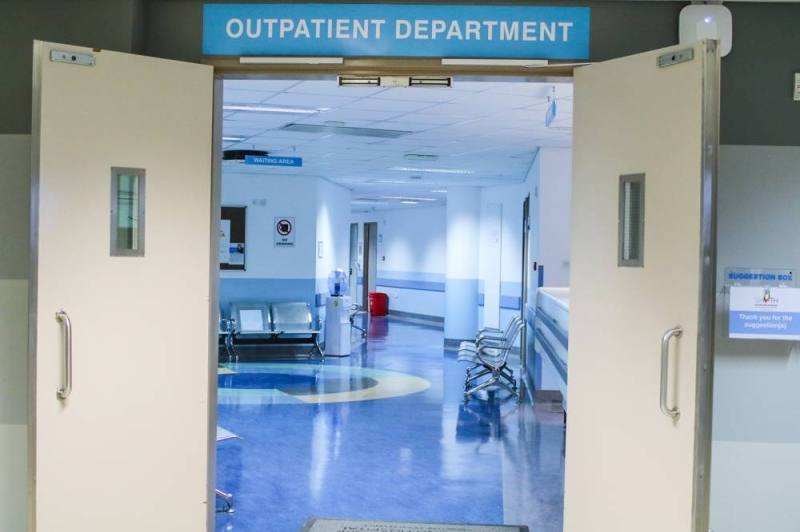A RAY OF HOPE
Batswana have waited for months and even years to get Computerized Tomography (CT) scans, surgery and Magnetic Resonance Imaging (MRI) among other services.
This is why the birth of Sir Ketumile Masire Teaching Hospital (SKMTH) brings a ray of hope. It is envisaged that with the opening of the hospital, waiting lists will be reduced and patients will not wait forever to be assisted.
Many patients complained that while doctors and nurses continued giving them drugs to temporarily ease pain and telling them to patiently wait, diseases ate away at their bodies.
Unfortunately, some died while waiting for proper diagnosis and treatment.
This was in no way a deliberate action of health practitioners, but the limited available resources in the country made it hard to attend to large numbers, while waiting lists piled.
In some instances, the country was even forced to send some Batswana outside the country for medical attention.
Expectation is that the new hospital will ease the burden on the ever-busy Princess Marina Hospital (PMH) which has for many years been the largest referral hospital in the country.
With SKMTH, the mother of all health facilities in Botswana, situated next to the University of Botswana in Gaborone, the Ministry of Health has outdone itself in ensuring access to quality health care in Botswana.
But unlike other government hospitals found in the country, SKMTH will operate as a private entity wholly-owned by government.
And just like in private hospitals such as Bokamoso and Sidilega among others, patients will be paying for services rendered.
This according to Permanent Secretary in the Ministry of Health, Grace Muzila is done to ensure that the facility is able to sustain and maintain high quality healthcare output.
Those incapable of paying but in need of service will be paid for by government as it has been the case when such patients were referred outside the country or to local private hospitals.
The Minister of Health Dr Edwin Dikoloti will officially launch the 450 bed facility tomorrow (Thursday).
Only Radiology services will be offered for now as the hospital intends to open in phases. If things go well, the hospital might attend to its very first patient on Thursday afternoon. The hospital facilities had only been chosen to support government's efforts to fight Covid-19 and no other medical transactions were taking place there.
Radiology services include screening of the brain, neck, spine, blood vessels, breast imaging and ultrasound, bone scan, prostate, information about joints, bile duct stone removal and many more.
According to SKMTH Commissioning Manager Ishmael Makone, the hospital will open in four phases depending on readiness. The intention is to attract highly-skilled medical personnel in an effort to have the quality that matches the modern day hospital.
Construction of the billion pula facility commenced in 2010 and it took four years to complete. In 2015, it was decided that the hospital will stand above the rest, at the summit of the healthcare hierarchical system in Botswana.
The facility will provide diagnosis of rare conditions and handle any form of procedure. All medical issues deemed too complex in both private and government hospitals will be referred to SKMTH.
This means that the only way for one to get to SKMTH is through a doctor’s referral note, as the hospital will not be dealing with first time diagnosis cases.
The hospital has 13 operating theatres, the biggest in the country, allowing surgeons to do their job efficiently without delays. A considerable number of patients will be attended to leading to shorter waiting periods.
In February 2020, SKMTH was the designated Covid-19 isolation centre. All critical Covid patients in the country were taken to SKMHT because of its highly advanced and sophisticated medical equipment.
The ultra-modern hospital has a huge oxygen tank measuring 25 tonnes which comes in handy when dealing with patients that have breathing difficulties.
They also have a 36-bed Intensive Care Unit (ICU) that is well-partitioned leading to easy separation of patients. For example, those in need of dialysis services are able to be given the much-needed care privately in the partitioned emergency section.
Another interesting feature about the hospital is that it has a pneumatic tube system that connects all departments with the hospital’s central pharmacy.
This would ensure that patients do not walk all the way to the dispensary to get their prescriptions.
John Gobotswang who works at SKMHT dispensary said they will be receiving what doctors have prescribed through the tube, they will then package the medicines and drugs then send them back through the tube.
According to Gobotswang, the consultation room is where everything can be done and the patient goes home thereafter.
Their medicine storage room is huge, enabling them to store as many drugs as possible to ensure that they do not run out of medication supplies.
Shortage of medication for non-communicable diseases such as Diabetes and High Blood Pressure is one of the challenges currently hitting the country hard and SKMHT is coming in well prepared.
The dispensary also has a counselling unit where patients will be talked to, guided and advised on the treatment they will be taking.
Furthermore, because a hospital can be such a depressing place to be, especially for children, SKMHT saw it fit to have a colourful kiddies section where children can play and have fun as part of their paediatric section.
This was a deliberate move by the hospital to cheer up the sick and restore hope, because a gloomy atmosphere plays a negative role in the mood of a child. Conversely, a cheerful child stands a better chance of fighting and recovering faster as compared to a sad and stressed child.
This is why the birth of Sir Ketumile Masire Teaching Hospital (SKMTH) brings a ray of hope. It is envisaged that with the opening of the hospital, waiting lists will be reduced and patients will not wait forever to be assisted.
Many patients complained that while doctors and nurses continued giving them drugs to temporarily ease pain and telling them to patiently wait, diseases ate away at their bodies.
Unfortunately, some died while waiting for proper diagnosis and treatment.
This was in no way a deliberate action of health practitioners, but the limited available resources in the country made it hard to attend to large numbers, while waiting lists piled.
In some instances, the country was even forced to send some Batswana outside the country for medical attention.
Expectation is that the new hospital will ease the burden on the ever-busy Princess Marina Hospital (PMH) which has for many years been the largest referral hospital in the country.
With SKMTH, the mother of all health facilities in Botswana, situated next to the University of Botswana in Gaborone, the Ministry of Health has outdone itself in ensuring access to quality health care in Botswana.
But unlike other government hospitals found in the country, SKMTH will operate as a private entity wholly-owned by government.
And just like in private hospitals such as Bokamoso and Sidilega among others, patients will be paying for services rendered.
This according to Permanent Secretary in the Ministry of Health, Grace Muzila is done to ensure that the facility is able to sustain and maintain high quality healthcare output.
Those incapable of paying but in need of service will be paid for by government as it has been the case when such patients were referred outside the country or to local private hospitals.
The Minister of Health Dr Edwin Dikoloti will officially launch the 450 bed facility tomorrow (Thursday).
Only Radiology services will be offered for now as the hospital intends to open in phases. If things go well, the hospital might attend to its very first patient on Thursday afternoon. The hospital facilities had only been chosen to support government's efforts to fight Covid-19 and no other medical transactions were taking place there.
Radiology services include screening of the brain, neck, spine, blood vessels, breast imaging and ultrasound, bone scan, prostate, information about joints, bile duct stone removal and many more.
According to SKMTH Commissioning Manager Ishmael Makone, the hospital will open in four phases depending on readiness. The intention is to attract highly-skilled medical personnel in an effort to have the quality that matches the modern day hospital.
Construction of the billion pula facility commenced in 2010 and it took four years to complete. In 2015, it was decided that the hospital will stand above the rest, at the summit of the healthcare hierarchical system in Botswana.
The facility will provide diagnosis of rare conditions and handle any form of procedure. All medical issues deemed too complex in both private and government hospitals will be referred to SKMTH.
This means that the only way for one to get to SKMTH is through a doctor’s referral note, as the hospital will not be dealing with first time diagnosis cases.
The hospital has 13 operating theatres, the biggest in the country, allowing surgeons to do their job efficiently without delays. A considerable number of patients will be attended to leading to shorter waiting periods.
In February 2020, SKMTH was the designated Covid-19 isolation centre. All critical Covid patients in the country were taken to SKMHT because of its highly advanced and sophisticated medical equipment.
The ultra-modern hospital has a huge oxygen tank measuring 25 tonnes which comes in handy when dealing with patients that have breathing difficulties.
They also have a 36-bed Intensive Care Unit (ICU) that is well-partitioned leading to easy separation of patients. For example, those in need of dialysis services are able to be given the much-needed care privately in the partitioned emergency section.
Another interesting feature about the hospital is that it has a pneumatic tube system that connects all departments with the hospital’s central pharmacy.
This would ensure that patients do not walk all the way to the dispensary to get their prescriptions.
John Gobotswang who works at SKMHT dispensary said they will be receiving what doctors have prescribed through the tube, they will then package the medicines and drugs then send them back through the tube.
According to Gobotswang, the consultation room is where everything can be done and the patient goes home thereafter.
Their medicine storage room is huge, enabling them to store as many drugs as possible to ensure that they do not run out of medication supplies.
Shortage of medication for non-communicable diseases such as Diabetes and High Blood Pressure is one of the challenges currently hitting the country hard and SKMHT is coming in well prepared.
The dispensary also has a counselling unit where patients will be talked to, guided and advised on the treatment they will be taking.
Furthermore, because a hospital can be such a depressing place to be, especially for children, SKMHT saw it fit to have a colourful kiddies section where children can play and have fun as part of their paediatric section.
This was a deliberate move by the hospital to cheer up the sick and restore hope, because a gloomy atmosphere plays a negative role in the mood of a child. Conversely, a cheerful child stands a better chance of fighting and recovering faster as compared to a sad and stressed child.








